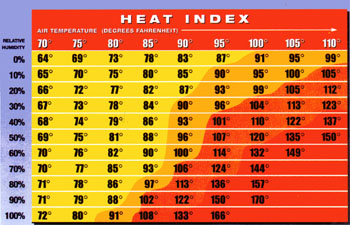As we all know, this summer is already warming up pretty quickly, and the first official day of summer isn’t until June 20th! OSHA is partnering with the National Oceanic and Atmospheric Administration (NOAA) on weather service alerts to incorporate worker safety precautions when heat alerts are issued across the United States. NOAA is including pertinent worker safety information on its Heat Watch Web page.
Because conditions are extremely hot with high humidity this season, companies would be wise to follow all advisories to keep their employees as safe as possible during this trying time.
Which brings up the question, how much water should we drink? Water is the body’s principle chemical component and makes up about 60 per cent of your body weight. Your entire body’s system depends on water. Lack of water can lead to dehydration, a condition that occurs when you don’t have enough water in your body to carry out normal functions. You can become tired and suffer energy loss with even mild dehydration. We’ve all been told to consume six to eight glasses of water per day. Dr. Margaret McCartney, a Scottish physician, states that there is no quality scientific evidence to support this recommendation, which she says can lead to over-hydration in some individuals. This eight-glass formula doesn’t fit everyone. The more active a person is, the more they will need to replace fluids. Larger people, pregnant and nursing women, and those who take dehydrating medications will likely need to add more water to their diet.
The Mayo Clinic staff suggests that your water needs depend on many factors, such as your health, how active you are, and where you live. Because water is essential to good health, needs vary by individual. If you use thirst as a guide for when to drink, by the time you are thirsty, you may already be slightly dehydrated. As you get older, your body is less able to sense dehydration and send your brain signals of thirst. Here are some tips to ward off dehydration, and make sure your body has the fluids it needs:
- Drink a glass of water with each meal and between each meal;
- Hydrate before, during and after exercise;
- Substitute sparkling water for alcoholic drinks at social events.
Many outside workers are exercising in temperatures that are very hot, causing them to sweat more. These folks will need to increase their water intake. Oral hydration solutions, such as Powdered Gatorade Mix, Powerade or CeraLyte may help those who are in situations that cause them to sweat heavily. Some experts recommend that bodies only need a minimal amount to keep the body in balance and give that energy kick. Sometimes simply taking sips or swishing a sports drink will do the trick.
At home, select foods that keep you hydrated and healthy. Strawberries, cantaloupes, watermelon, and peaches are packed full of water and potassium, which is the electrolyte lost when your body sweats. This is a great way to balance fluids that your body needs, and regulate your heartbeat and circulation. Plus – they are delicious!
Rest, shade and water are very important for your employees. Individuals know what their body needs, and they must be diligent about taking the time to stop for a drink of water throughout the day. You can find more information on the OSHA website, as well as NOAA’s website. Try to stay cool, take breaks during the day, and stay hydrated!
Last, but not least, wear a hat, sunscreen, long-sleeve shirts if possible, and safety sunglasses that offer UVA and UVB protection for your eyes. It’s going to be a long, hot summer, so take all the precautions you can to avoid heat-related illness.
